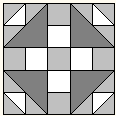Although they sound a bit intimidating, 25 patch blocks are really common - you might be surprised just how many you have encountered. As always, these are just my thoughts on how to approach 25 patch calculations :o).
So, what size should my 25 patch be?
Quilters are pretty smart - we like to make things easier for ourselves by choosing a block size that means cutting fabric in whole or half-inch increments, rather than horrible fractions (like 3/8" for example). Not only is it easier to get your head around whole numbers and the maths involved, it seems to be more comfortable to accurately cut fabric - possibly because the whole and half-inch markings on rulers are generally easier to see.
Since a 25-patch block is five squares across by five squares down, it would make sense to choose a finished block size that is divisible by five (ie 5", 10", 15", 20" etc). This will mean dealing with whole numbers, rather than fractions.
For example, if you chose to make a 10" finished 25 patch block, you could calculate the finished size of each of the squares by calculating 10/5 = 2, a nice round number. This is far easier than choosing a finished block size of, say, 16", where you would be dealing with difficult fractions when cutting fabric, which is far more likely to end up with wonky points and blocks that aren't quite the right size.
What about seam allowance?
Learning how to add seam allowance to your measurements is one of the big tricks in quilty maths - and it is critical to learn how to do it so you end up with blocks that are the right size. If you don't account for the extra fabric that will end up within the seam allowance, you will be cutting fabric the wrong size and end up with blocks that are not the size you want.
Quilters use a 1/4" seam allowance, so a 1/4" on each side of every piece of fabric will be 'lost' in the seam when you join them to another piece of fabric.
For example, if the desired finished size of a square is 3",
So the rule of thumb is to add 0.5" to each finished measurement in the block.
So how do I know what size to cut my fabric for a 25 patch block?
Some 25-patch blocks are a combination of units laid out in a 5x5 grid - for example the 25 patch block
As I mentioned above, to calculate the size of the squares, you simply need to divide the finished block size by 5. So if you were making a 10" finished block, you divide 10 by 5 = 2, and then add 1/2" to find your cutting measurements. So for a 10" finished 25 patch block, you would need to cut your squares at 2.5".
However, it is quite common to get 25-patch blocks with a layout like this:
Some examples of actual blocks like this are Duck and Ducklings (cutest name ever or what?)
and the 5 patch Shoo Fly.
In each of these blocks, the larger section takes up a 2x2 area on the grid, so when calculating the size of these units, you would need to multiply your finished size block by 2/5. For example, if you were making a 10" finished block, you would calculate 10 x 2/5 = 4, and then add your seam allowance to get an unfinished size of 4 1/2" for those units.
For the 5 Patch Shoo Fly block, this would simply mean making HSTs and trimming them down to 4.5".
I hope this has been a helpful post, but if you have any questions please just send me an email or leave a comment and I'll answer as best I can. As always, if you make something using any of our tutorials in the series you can use the hashtag #decipheryourquilt on Instagram, or add it to the Flickr group.

.jpg)

.jpg)
.jpg)




7 comments:
This is an excellent clear explanation of how to calculate these blocks.
Love your series! Thank you, very appreciated.
Ta x
another fab post
Yes to above comment. Another good post on basics that we can all use as a reminder of the math and breakdown of a block..
So is there such a thing as a 36 patch block? Guess I find out next time :oD Or maybe it'll be a 49 patch...
What size would the blocks have to be for a 12" finished block?
Post a Comment